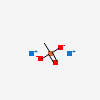Disodium methylarsonate
- Disodium methylarsonate
- 144-21-8
- DISODIUM METHANEARSONATE
- Sodium methylarsonate
- DSMA
- Create:2005-08-08
- Modify:2025-01-11
 Monosodium methanearsonate (annotation moved to).
Monosodium methanearsonate (annotation moved to).
- disodium methanearsonate
- methanearsonic acid
- methylarsonate
- methylarsonic acid
- methylarsonous acid
- monomethylarsonic acid
- monomethylarsonic acid, ammonium, iron (3+) salt
- monomethylarsonic acid, calcium salt (2:1)
- monomethylarsonic acid, dimercury (1+) salt
- monomethylarsonic acid, dipotassium salt
- monomethylarsonic acid, disodium salt
- monomethylarsonic acid, iron (2+) salt (3:2)
- monomethylarsonic acid, iron salt
- monomethylarsonic acid, monoammonium salt
- monomethylarsonic acid, monocalcium salt
- monomethylarsonic acid, monosodium salt
- monomethylarsonic acid, zinc salt
- monosodium methanearsonate
- MSMA
- sodium methanearsonate
- Disodium methylarsonate
- 144-21-8
- DISODIUM METHANEARSONATE
- Sodium methylarsonate
- DSMA
- Metharsinat
- Disomear
- Arrhenal
- Arsinyl
- Arsynal
- Diarsen
- Metharsan
- Stenosine
- Tonarsan
- Tonarsin
- Methar
- Namate
- Dimet
- Sodar
- Somar
- Neo-Asycodile
- Weed broom
- Maa sodium salt
- Cacodyl New
- Jon-Trol
- Weed-Hoe
- Di-tac
- Weed-e-rad
- Cralo-E-rad
- Chipco Crab Kleen
- Sodium metharsonate
- Methylarsonic acid, disodium salt
- Ansar DSMA Liquid
- Disodium methylarsenate
- Ansar 184
- Disodium methanearsenate
- Crab-3-rad 100
- Ansar 8100
- Dal-E-Rad 100
- Disodium monomethylarsonate
- Arsonic acid, methyl-, disodium salt (9CI)
- 7NK4BV40VN
- DMA 100
- Methanearsonic acid, disodium salt
- Dinate
- DSMA liquid
- Versar DSMA LQ
- Drexel DSMA liquid
- Methar 30
- Caswell No. 405
- Disodium methanarsonate
- Weed-E-rad 360
- Disodium methyl arsonate
- Weed-E-Rad DMA Powder
- Methyl Arsonic Acid Disodium Salt (~40%, Contain Sodium Sulfate)
- DMA (VAN)
- Methylarsonat disodny [Czech]
- Methylarsonat disodny
- NSC-5270
- HSDB 1701
- NSC 5270
- EINECS 205-620-7
- Arsonic acid, methyl-, disodium salt
- UNII-7NK4BV40VN
- EPA Pesticide Chemical Code 013802
- Sodiummethylarsonate
- SCHEMBL28552
- METHYLARSONATE DISODIUM
- CHEMBL2289061
- DTXSID4032665
- Methyl-arsonic acid disodium salt
- DISODIUM MONOMETHANEARSONATE
- AKOS015913952
- AKOS027382520
- DISODIUM METHANEARSONATE [HSDB]
- METHANEARSONIC ACID DISODIUM SALT
- METHYLARSONATE DISODIUM [WHO-DD]
- DISODIUM METHANEARSONATE [WHO-DD]
- disodium;methyl-dioxido-oxo-lambda5-arsane
- DB-255298
- NS00079251
- METHANEARSONIC ACID DISODIUM SALT [MI]
- Q3066717
 Monosodium methanearsonate (annotation moved to)
Monosodium methanearsonate (annotation moved to)

H301 (97.4%): Toxic if swallowed [Danger Acute toxicity, oral]
H331 (97.4%): Toxic if inhaled [Danger Acute toxicity, inhalation]
H400 (100%): Very toxic to aquatic life [Warning Hazardous to the aquatic environment, acute hazard]
H410 (97.4%): Very toxic to aquatic life with long lasting effects [Warning Hazardous to the aquatic environment, long-term hazard]
P261, P264, P270, P271, P273, P301+P316, P304+P340, P316, P321, P330, P391, P403+P233, P405, and P501
(The corresponding statement to each P-code can be found at the GHS Classification page.)
Aggregated GHS information provided per 39 reports by companies from 2 notifications to the ECHA C&L Inventory. Each notification may be associated with multiple companies.
Information may vary between notifications depending on impurities, additives, and other factors. The percentage value in parenthesis indicates the notified classification ratio from companies that provide hazard codes. Only hazard codes with percentage values above 10% are shown.
Acute Tox. 3 (97.4%)
Acute Tox. 3 (97.4%)
Aquatic Acute 1 (100%)
Aquatic Chronic 1 (97.4%)
IMAP assessments - Arsonic acid, methyl-, disodium salt: Environment tier I assessment
IMAP assessments - Arsonic acid, methyl-, disodium salt: Human health tier I assessment
Patents are available for this chemical structure:
https://patentscope.wipo.int/search/en/result.jsf?inchikey=SDIXRDNYIMOKSG-UHFFFAOYSA-L
- Australian Industrial Chemicals Introduction Scheme (AICIS)Arsonic acid, methyl-, disodium salthttps://services.industrialchemicals.gov.au/search-assessments/
- ChemIDplusDisodium methanearsonatehttps://pubchem.ncbi.nlm.nih.gov/substance/?source=chemidplus&sourceid=0000144218ChemIDplus Chemical Information Classificationhttps://pubchem.ncbi.nlm.nih.gov/source/ChemIDplus
- EPA DSSToxDisodium methanearsonatehttps://comptox.epa.gov/dashboard/DTXSID4032665CompTox Chemicals Dashboard Chemical Listshttps://comptox.epa.gov/dashboard/chemical-lists/
- EPA Safe Drinking Water Act (SDWA)Disodium methanearsonatehttps://www.epa.gov/sdwa/2021-human-health-benchmarks-pesticides
- European Chemicals Agency (ECHA)LICENSEUse of the information, documents and data from the ECHA website is subject to the terms and conditions of this Legal Notice, and subject to other binding limitations provided for under applicable law, the information, documents and data made available on the ECHA website may be reproduced, distributed and/or used, totally or in part, for non-commercial purposes provided that ECHA is acknowledged as the source: "Source: European Chemicals Agency, http://echa.europa.eu/". Such acknowledgement must be included in each copy of the material. ECHA permits and encourages organisations and individuals to create links to the ECHA website under the following cumulative conditions: Links can only be made to webpages that provide a link to the Legal Notice page.https://echa.europa.eu/web/guest/legal-noticeDisodium methylarsonatehttps://echa.europa.eu/substance-information/-/substanceinfo/100.005.110Disodium methylarsonate (EC: 205-620-7)https://echa.europa.eu/information-on-chemicals/cl-inventory-database/-/discli/details/25058
- FDA Global Substance Registration System (GSRS)LICENSEUnless otherwise noted, the contents of the FDA website (www.fda.gov), both text and graphics, are not copyrighted. They are in the public domain and may be republished, reprinted and otherwise used freely by anyone without the need to obtain permission from FDA. Credit to the U.S. Food and Drug Administration as the source is appreciated but not required.https://www.fda.gov/about-fda/about-website/website-policies#linkingDISODIUM METHYLARSONATEhttps://gsrs.ncats.nih.gov/ginas/app/beta/substances/7NK4BV40VN
- Hazardous Substances Data Bank (HSDB)DISODIUM METHANEARSONATEhttps://pubchem.ncbi.nlm.nih.gov/source/hsdb/1701
- NJDOH RTK Hazardous Substance Listmethanearsonic acid, disodium salthttp://nj.gov/health/eoh/rtkweb/documents/fs/4106.pdf
- Risk Assessment Information System (RAIS)LICENSEThis work has been sponsored by the U.S. Department of Energy (DOE), Office of Environmental Management, Oak Ridge Operations (ORO) Office through a joint collaboration between United Cleanup Oak Ridge LLC (UCOR), Oak Ridge National Laboratory (ORNL), and The University of Tennessee, Ecology and Evolutionary Biology, The Institute for Environmental Modeling (TIEM). All rights reserved.https://rais.ornl.gov/
- ChEMBLLICENSEAccess to the web interface of ChEMBL is made under the EBI's Terms of Use (http://www.ebi.ac.uk/Information/termsofuse.html). The ChEMBL data is made available on a Creative Commons Attribution-Share Alike 3.0 Unported License (http://creativecommons.org/licenses/by-sa/3.0/).http://www.ebi.ac.uk/Information/termsofuse.html
- EPA Chemical and Products Database (CPDat)Disodium methanearsonatehttps://comptox.epa.gov/dashboard/DTXSID4032665#exposureEPA CPDat Classificationhttps://www.epa.gov/chemical-research/chemical-and-products-database-cpdat
- Haz-Map, Information on Hazardous Chemicals and Occupational DiseasesLICENSECopyright (c) 2022 Haz-Map(R). All rights reserved. Unless otherwise indicated, all materials from Haz-Map are copyrighted by Haz-Map(R). No part of these materials, either text or image may be used for any purpose other than for personal use. Therefore, reproduction, modification, storage in a retrieval system or retransmission, in any form or by any means, electronic, mechanical or otherwise, for reasons other than personal use, is strictly prohibited without prior written permission.https://haz-map.com/AboutDisodium methanearsonatehttps://haz-map.com/Agents/5021
- EPA Pesticide Ecotoxicity Database
- Japan Chemical Substance Dictionary (Nikkaji)
- SpectraBase
- Springer Nature
- Wikidatadisodium methylarsonatehttps://www.wikidata.org/wiki/Q3066717
- WikipediaDisodium methyl arsonatehttps://en.wikipedia.org/wiki/Disodium_methyl_arsonate
- PubChem
- Medical Subject Headings (MeSH)LICENSEWorks produced by the U.S. government are not subject to copyright protection in the United States. Any such works found on National Library of Medicine (NLM) Web sites may be freely used or reproduced without permission in the U.S.https://www.nlm.nih.gov/copyright.htmlmonomethylarsonic acidhttps://www.ncbi.nlm.nih.gov/mesh/67020300
- GHS Classification (UNECE)GHS Classification Treehttp://www.unece.org/trans/danger/publi/ghs/ghs_welcome_e.html
- NORMAN Suspect List ExchangeLICENSEData: CC-BY 4.0; Code (hosted by ECI, LCSB): Artistic-2.0https://creativecommons.org/licenses/by/4.0/NORMAN Suspect List Exchange Classificationhttps://www.norman-network.com/nds/SLE/
- EPA Substance Registry ServicesEPA SRS List Classificationhttps://sor.epa.gov/sor_internet/registry/substreg/LandingPage.do
- MolGenieMolGenie Organic Chemistry Ontologyhttps://github.com/MolGenie/ontology/
- PATENTSCOPE (WIPO)SID 388314842https://pubchem.ncbi.nlm.nih.gov/substance/388314842

 CID 8948 (Methylarsonic acid)
CID 8948 (Methylarsonic acid) CID 5360545 (Sodium)
CID 5360545 (Sodium)